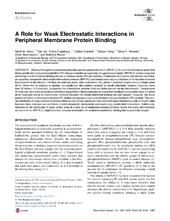| dc.contributor.author | Khan, Hanif Muhammad | |
| dc.contributor.author | He, Tao | |
| dc.contributor.author | Fuglebakk, Edvin | |
| dc.contributor.author | Grauffel, Cédric | |
| dc.contributor.author | Yang, Boqian | |
| dc.contributor.author | Roberts, Mary F. | |
| dc.contributor.author | Gershenson, Anne | |
| dc.contributor.author | Reuter, Nathalie | |
| dc.date.accessioned | 2016-08-31T12:14:21Z | |
| dc.date.available | 2016-08-31T12:14:21Z | |
| dc.date.issued | 2016-03 | |
| dc.Published | Biophysical Journal 2016, 110(6):1367-1378 | eng |
| dc.identifier.issn | 1542-0086 | en_US |
| dc.identifier.uri | https://hdl.handle.net/1956/12697 | |
| dc.description.abstract | Bacillus thuringiensis phosphatidylinositol-specific phospholipase C (BtPI-PLC) is a secreted virulence factor that binds specifically to phosphatidylcholine (PC) bilayers containing negatively charged phospholipids. BtPI-PLC carries a negative net charge and its interfacial binding site has no obvious cluster of basic residues. Continuum electrostatic calculations show that, as expected, nonspecific electrostatic interactions between BtPI-PLC and membranes vary as a function of the fraction of anionic lipids present in the bilayers. Yet they are strikingly weak, with a calculated ΔGel below 1 kcal/mol, largely due to a single lysine (K44). When K44 is mutated to alanine, the equilibrium dissociation constant for small unilamellar vesicles increases more than 50 times (∼2.4 kcal/mol), suggesting that interactions between K44 and lipids are not merely electrostatic. Comparisons of molecular-dynamics simulations performed using different lipid compositions reveal that the bilayer composition does not affect either hydrogen bonds or hydrophobic contacts between the protein interfacial binding site and bilayers. However, the occupancies of cation-π interactions between PC choline headgroups and protein tyrosines vary as a function of PC content. The overall contribution of basic residues to binding affinity is also context dependent and cannot be approximated by a rule-of-thumb value because these residues can contribute to both nonspecific electrostatic and short-range protein-lipid interactions. Additionally, statistics on the distribution of basic amino acids in a data set of membrane-binding domains reveal that weak electrostatics, as observed for BtPI-PLC, might be a less unusual mechanism for peripheral membrane binding than is generally thought. | en_US |
| dc.language.iso | eng | eng |
| dc.publisher | Elsevier | en_US |
| dc.rights | Attribution CC BY-NC-ND | eng |
| dc.rights.uri | http://creativecommons.org/licenses/by-nc-nd/4.0/ | eng |
| dc.title | A Role for Weak Electrostatic Interactions in Peripheral Membrane Protein Binding | en_US |
| dc.type | Peer reviewed | |
| dc.type | Journal article | |
| dc.date.updated | 2016-08-29T08:45:56Z | |
| dc.description.version | publishedVersion | en_US |
| dc.rights.holder | Copyright 2016 The Authors | en_US |
| dc.identifier.doi | https://doi.org/10.1016/j.bpj.2016.02.020 | |
| dc.identifier.cristin | 1376166 | |
| dc.relation.project | Notur/NorStore: NN4700K | |
| dc.relation.project | Norges forskningsråd: 214167 | |

